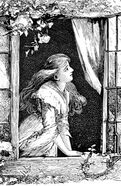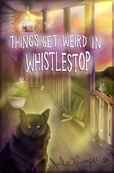 Blood on the Mausoleum by Julie Carpenter My first collection of stories takes place in a small town called Whistlestop. Now, you might think small towns are boring and that it would be easier to write a set of exciting stories if they were set in a big city. That may be true to some extent. Wherever you have more people, you’re going to have excitement and drama right there, right under your nose. No need to go poking around for it most of the time. But, small towns have their dramas too. Stories that stick in the collective memory. These can be legends that everyone knows about, or secrets and hidden tragedies that no one wants to discuss openly that still somehow infiltrate the collective consciousness by some sort of osmosis. Every little village has a story someone desperately wants to bury, reduce to whispers, inter in silence. Some of these stories remind us that life is fragile and temporary, and quite possibly weirder than we thought. Sometimes stories need time to ferment until they return to haunt us with the strange metaphysical possibilities of ghosts and otherworldly visitations. And sometimes they even shape us. The town I grew up in, Cleveland, TN, was no exception. One of the stories that stuck with me was a ghost story. I actually used this bit of history in “A Small Haunting,” the third story in the Whistlestop collection. While it may seem ornamental, as though it made it into the book in passing, it was no afterthought. I think this story helped make me a writer. There’s no point in retelling it all over again, so here’s the excerpt: “A Small Haunting” (From Things Get Weird in Whistlestop, by Julie Carpenter) My hometown had a ghost, as every small town should. Sometime in the late eighteen-hundreds, the seven-year-old daughter of a wealthy family crossed the porous border from girlhood into ghost-hood when she was thrown from her grandfather’s buggy and into the path of an oncoming train. Her bereaved family erected a white marble mausoleum, a tiny, gothic Taj Mahal, behind her church. The small spired building sucked sunlight into its thick mottled shell, appearing ghostly even at noon, but glowed like polished metal in the moonlight. It formed the architecture of many of my darkest dreams. By the time I was a girl, the tomb had been there at least a hundred years. The elaborately carved arch of pure white marble bore a curious crimson stain. Townsfolk took this to be the sign of an unrestful spirit. Other members of her family soon began to join her, an infant brother who lived only hours, her father, who died of blood poisoning after slipping on ice. When the mother was struck by an automobile, she was reunited with her little family as well. As each family member moved in, the red stain deepened. This embellishment of the family tomb was the extent of mischief our ghosts were willing to make. The story was delightfully creepy, but not too terrible for a small and fragile child like myself, a perfect haunting for a proper small town. An air of quiet sadness emanated from the little garden with the marble sepulcher at its center, a ghostly reminder of how easy it is to cross from here to there. That’s as close to a ghost as I’ve ever come. Until Whistlestop. Now…I don’t know exactly how accurate all the historical details are from the source that I used, but the story is based on the life and death of a young girl named Nina Craigmiles. She lived and breathed and died in my town. She is interred there to this day. And her story deeply affected another little girl nearly one hundred years later...me. I was an empathetic child, and the story burrowed right down into my fragile heart, a reminder that death comes with raging injustice, even in sleepy towns where nothing ever seems to happen, even in places where the pace of life is slow enough to sweep the big tragedies out of everyday sight. I suppose all children experience that moment of shock where death suddenly becomes real and Nina’s story hit me hard. (We all have that heartrending moment when we realize the loss that death represents. My older daughter carried in a dead baby bird one day that she was going to make better with her breath. It's almost more heart-rending to watch a child experience that moment than it is to go through it yourself.) But the story stuck with me in another way as well. It stuck with me as a story. I was probably a little older than Nina when I heard her history and by the time I heard it, it had been shaped into narrative. It had a beginning that shocked, some sad twists, and a haunting ending. I held this story in my brain, and without thinking about it in technical terms, I began turning it over in my head. I thought about the elements and how they came together. How the white marble seemed as serene as death itself. How the scarlet streaks were like a hand clawing a furious protest against such a cruel fate. I saw the marble tomb with my own eyes when we walked past it. I saw it in winter, spring, summer and fall…the aloof white marble attempting to pretend it was immune to tragedy with the slap mark of red across its face. Story. Symbolism. Those wormed their way into my writerly little heart. I learned about Nina at about the same time that my sixth-grade class took a trip to the small graveyard across the street from my school. I think that perhaps some historically significant residents were buried there? I can’t really remember the reason. I think it was in the autumn, or perhaps my brain linked the end of summer and falling leaves with what I felt as I walked past the smooth, eroding stones. I remember finding a grave with the name Evelyn still visible on it. I wasn’t very good at math, but I managed to subtract her birth date from the day of her death and I was struck by the number. She was six years old. And suddenly, the old, crumbling gravestone, with its shock of grief barely dissipated in a century, gave me a sudden pang of longing – the longing to know her story. That night, Evelyn visited me in a dream and led me back to the graveyard, barefoot, in her decaying dress, trying wordlessly to tell me something…but I couldn’t tell what. In spite of the fact that Evelyn couldn’t tell me her story, she took up residence in my brain. In fact, these two young girls, who sojourned so briefly on this side of the veil, both stayed with me somehow, one whose story I knew a little of, the other whose story was a complete mystery, except that she lived and died. I pictured them. I thought about them. Their stories were oddly vivid to me, not in spite of, but because of their physical absence. I wrote my first story shortly after the trip to the graveyard. It was the tale of a girl about my age who watched a funeral from the window of her big Victorian house and then died within a week. I don’t remember much about the story, except the girl’s fascination with the funeral procession and the heavy smell of honeysuckles, which have always seemed to me to possess the fragrance of the netherworld. And there, as the story wound to its close, was another funeral procession just like the first, ending in the finality of the ice white tomb and angry protest of scarlet streaks slowly spreading onto its surface. Into the mirror of this fabricated child, I reflected myself, my own fears. It was an empowering and frightening moment for me. Death was taboo, perhaps like the eye of Sauron, it would fasten on me if I spoke of it. At the same time I was afraid to consider the possibility, I was compelled to acknowledge it, and story was the only way I had. Perhaps a fictional character was an effective feint. Perhaps a story would allow me to think about my fears without attracting the attention of the fates. In looking back over this post, I suppose that what I’m trying to say in my own way, is thank you. To the town for preserving its stories. To Nina and Evelyn, though I never knew them, for being strange and empathetic companions, for helping me tell stories, and for teaching me something about life and death. It’s also a tribute to the streaks of scarlet, like graffiti on the marble, a small protest, but a protest nonetheless, against the immovable and heavy destiny of death. Now, I believe I will go out and smell the honeysuckles and think about my childhood companions and writing teachers, the two little girls from a century ago. *The link for Things Get Weird in Whistlestop above is for IndieBound, but you can also purchase it through Amazon, Barnes and Noble, Target, and Other Major book sellers. **Here's a link to the local Cleveland, TN paper, with more information about their local ghost story.  Bio: Julie Carpenter is the author of Things Get Weird in Whistlestop and creator of the Sacred Chickens website. She is dedicated to telling stories and making sure that indie writers and publishers have a way to be heard. She uses narrative, her own and others’, to help interpret the world. She has a Master of Professional Writing from the University of Memphis, with an emphasis in Composition Theory. She wants to bend reality one story at a time. Julie’s work has appeared in Fiction on the Web and her Letter to Essie was included in The New Guard Volume
2 Comments
3/1/2024 02:59:35 am
Julie Carpenter nails it with "Blood on the Mausoleum," proving small towns are gold mines for the weird and wonderful. Who knew Whistlestop's eerie tales could be so captivating? A young girl's tragic fate turning into a haunting legend shows just how stories shape us. Carpenter's knack for drawing deep, dark beauty from local lore is spot on. It's a chilling yet charming reminder that sometimes, the best tales come from the most unexpected places.
Reply
Leave a Reply. |

Click Photo above to buy ebook or paperback from Amazon.
Here's the link to Barnes and Noble Or order through your favorite independent bookstore! Categories
All
|
 RSS Feed
RSS Feed